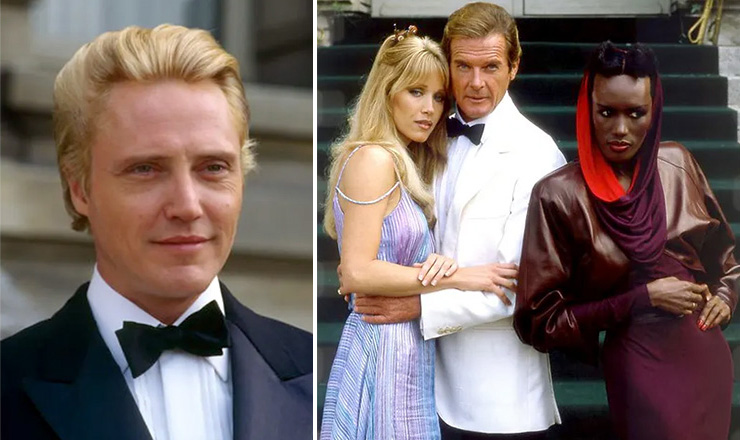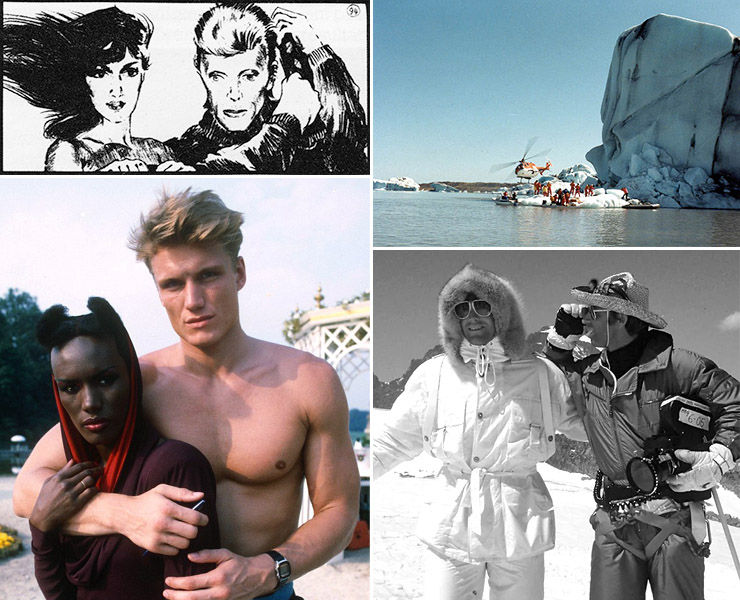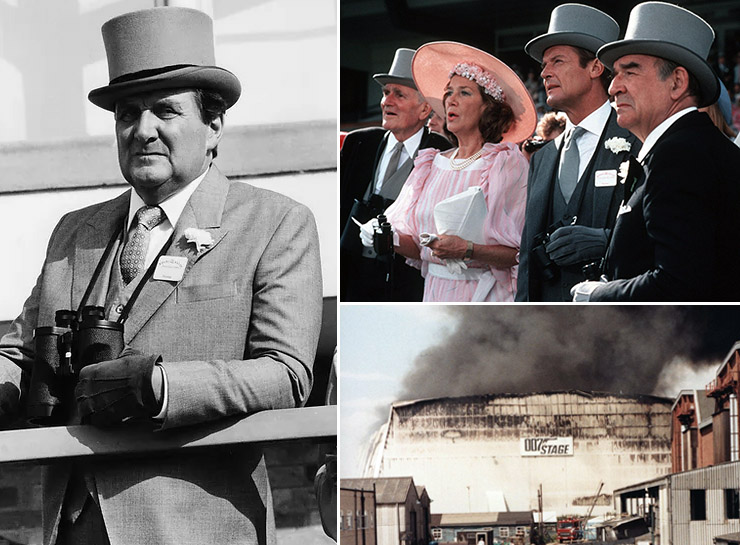 |
|
To celebrate the 40th
Anniversary of the release of Roger Moore’s swansong as 007, KEVIN HARPER
takes a look back at the production of A View To A Kill – the 14th
entry in the long-running James Bond film series. |
 |
|
At the end of
Octopussy (1983) it was
announced that James Bond would return in ‘From A View To A Kill’ – the
title of the opening short story of Ian Fleming’s 1960 anthology FOR YOUR
EYES ONLY. With no full-length novels left to adapt, EON Productions had
looked for inspiration in the short stories and successfully integrated
elements from them into the screenplay of
For Your Eyes Only (1981),
and to a lesser degree in Octopussy (1983). Veteran James Bond
screenwriter Richard Maibaum delivered a 27-page treatment for the 14th
James Bond film on October 26, 1983, which retained the title and French
setting of the short story
originally published in the Daily Express
newspaper in September 1959, under the title Murder Before Breakfast.
Maibaum introduced the character of Zorin (originally named Zorn), who has
been genetically engineered by ex-Nazis in South America, and his plan to
corner the microchip market by flooding Silicon Valley, in a storyline
very similar to the 1964 classic,
Goldfinger. After director
John Glen and
co-producer Michael G.
Wilson had begun scouting potential locations in San Francisco, it
became clear the new film should utilise the iconic Golden Gate Bridge,
and a second draft treatment included the city, and also scenes at a
horse-breeding ranch. This second draft was further revised to include the
pre-credit ski chase and Zorin’s airship. The production engaged the
services of Airship Industries in Bedfordshire, who although were
unable to provide an Airship in San Francisco, did say they were already
flying one for Fuji Film in the city as part of the Japanese
company’s promotion of their sponsorship of the 1984 Summer Olympics in
Los Angeles. A small crew including director John Glen and second unit
photographer Arthur Wooster captured footage of the Fuji blimp and
the Golden Gate Bridge, which was used in the finished film. |
 |
|
ABOVE: (top left)
A View To A Kill Director John Glen, Production Supervisor
Anthony Waye, 2nd Unit Director Arthur Wooster and Cinematographer
Alan Hume photograph the Fuji blimp as it approaches the
Golden Gate Bridge in San Francisco during pre-production on the
film. (bottom left) One of the shots of the Fuji blimp
appears in the finished film. The various sized models of Zorin's
airship were finished in the same red and green colour scheme as
the Fuji logo, so when seen from a distance it could double
as the Zorin Industries Skyship 500. (right) Veteran James
Bond film screenwriter Richard Maibaum working on the script for
A View To A Kill (1985). |
|
|
|
In April 1984, it was
announced that the title of the new James Bond film would be A View To
A Kill, and production would begin in June. Although Octopussy
had proved the overall winner at the box-office in the so-called ‘Battle
of the Bonds’, against Never Say
Never Again, Sean Connery’s final return to the James Bond role,
many people thought that Roger Moore was now too old to continue playing
Ian Fleming’s secret agent, as he was now relying more regularly on stunt
doubles to perform most of the action sequences. EON Productions, however,
were still keen to continue with Moore, and at the age of 57 he agreed to
play James Bond for a 00-seventh time in A View To A Kill. As the
production was to be largely filmed in the USA, two American performers
were cast in the lead roles opposite Moore; New York stage and screen
actor Christopher Walken was cast as the villain Max Zorin (after singer
David Bowie was approached as an off-beat choice). Ironically, Christopher
Walken and Roger Moore had already appeared together in a 1953 episode of
the American TV drama series Robert Montgomery Presents. Walken was
an uncredited child actor in the episode titled The Wind Cannot Read.
Best-known for appearing in the hit TV series Charlie's Angels,
model and actress Tanya Roberts took on the role of geologist Stacey
Sutton. Jamaican-born singer and actress Grace Jones was cast as Zorin’s
sidekick May Day, with her boyfriend Dolph Lundgren making his acting
debut in the small role of Russian Agent Venz. Patrick Macnee was engaged
to play a horse-trainer Sir Godfrey Tibbett, working undercover as Bond’s
chauffeur. Macnee became the third actor from the hit TV series The
Avengers (1961-69) to join the Bond franchise, following in the
footsteps of his co-stars
Honor Blackman in Goldfinger (1964) and
Diana Rigg in
On Her Majesty’s Secret Service
(1969). His New Avengers (1976-77) co-star Joanna Lumley had also
appeared in OHMSS as The English Girl. Roger Moore and Patrick
Macnee were old friends from their television days, with The Saint
and The Avengers filmed around the same time at Elstree Studios,
and their on-screen chemistry in A View To A Kill is one of the
high points of the film. Moore and Macnee had earlier starred together as
Sherlock Holmes and Dr. Watson in the forgettable US television film
Sherlock Holmes in New York (1976), and again in The Sea Wolves
(1980). |
 |
|
ABOVE: (top left) A
storyboard drawn during pre-production showed pop star David Bowie
as Max Zorin and his sidekick May Day as Caucasian. Bowie declined
the role and later said “‘Yes, I was offered that. I think for
an actor it’s probably an interesting thing to do, but I think for
somebody from rock ’n’ roll, it’s more of a clown performance. And
I didn’t want to spend five months watching my double fall off
mountains.” (top right) The second unit filmed part of the
pre-title sequence at the Jökulsárlón glacier lagoon in Iceland.
(bottom left) Grace Jones played May Day in A View To A Kill
and her then boyfriend Dolph Lundgren had a small role as Russian
Agent Venz. (bottom right) Stunt performer John Eaves (doubling
for Roger Moore) and third unit director champion skier Willy
Bogner on location at Piz Palü on the Vedretta di Scerscen
Inferiore glacier in the Swiss Alps. |
|
|
|
The first draft
screenplay by Richard Maibaum and Michael G. Wilson was delivered on June
5, 1984, with a revised shooting script following two weeks later. The
second unit began filming at Royal Ascot Racecourse for two days beginning
June 19, 1984, and then relocated to Iceland to film part of the pre-title
sequence. Production Designer
Peter Lamont had
planned to build the interior of the ‘Main Strike’ mine set on Pinewood’s
‘007 Stage’ – originally conceived by
Ken Adam and
constructed in 1976 to house the set he designed for the interior of the
Liparus supertanker in
The Spy Who Loved Me (1977). On June 27, 1984, disaster struck
when the ‘007 Stage’
burned down during the filming of Ridley Scott's Legend (1985).
With production due to start on
A View To A Kill (1985), EON
Productions set about rebuilding the stage and the production schedule was
hastily rearranged – including additional footage required for the
pre-title ski sequence (originally planned for Scotland but abandoned due
to mild weather) – with champion skier
Willy Bogner now
directing the third unit on a glacier in the Swiss Alps, which took place
over four weeks in July/August 1984. |
 |
|
ABOVE: (left)
Patrick Macnee as Sir Godfrey Tibbett on location at Royal Ascot
Racecourse. (top right) Desmond Llewelyn (Q), Lois Maxwell
(Moneypenny), Roger Moore (James Bond) and Robert Brown (M) on
location at Ascot during filming of A View To A Kill in
June 1984. (bottom right) On June 27, 1984, disaster struck when
the ‘007 Stage’ burned down during the filming of Ridley Scott's
Legend (1985) which resulted in the shooting schedule for
A View To A Kill being hastily rearranged. |
|
|
|
|
CONTINUED
>> |

